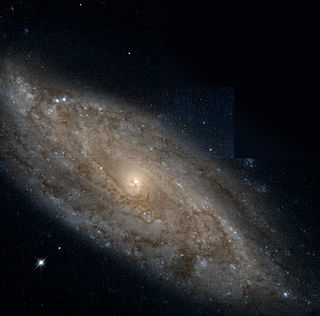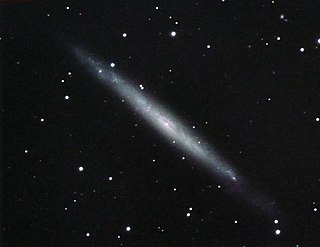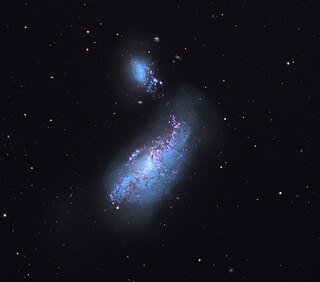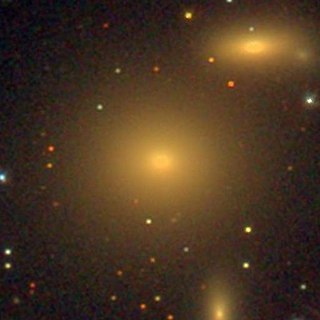Related Research Articles

The following outline is provided as an overview and topical guide to space science:

An astronomical object, celestial object, stellar object or heavenly body is a naturally occurring physical entity, association, or structure that exists within the observable universe. In astronomy, the terms object and body are often used interchangeably. However, an astronomical body or celestial body is a single, tightly bound, contiguous entity, while an astronomical or celestial object is a complex, less cohesively bound structure, which may consist of multiple bodies or even other objects with substructures.

The American Astronomical Society is an American society of professional astronomers and other interested individuals, headquartered in Washington, DC. The primary objective of the AAS is to promote the advancement of astronomy and closely related branches of science, while the secondary purpose includes enhancing astronomy education and providing a political voice for its members through lobbying and grassroots activities. Its current mission is to enhance and share humanity's scientific understanding of the universe as a diverse and inclusive astronomical community.

Messier 61 is an intermediate barred spiral galaxy in the Virgo Cluster of galaxies. It was first discovered by Barnaba Oriani on May 5, 1779, six days before Charles Messier discovered the same galaxy. Messier had observed it on the same night as Oriani but had mistaken it for a comet. Its distance has been estimated to be 45.61 million light years from the Milky Way Galaxy. It is a member of the M61 Group of galaxies, which is a member of the Virgo II Groups, a series of galaxies and galaxy clusters strung out from the southern edge of the Virgo Supercluster.

Halton Christian "Chip" Arp was an American astronomer. He was known for his 1966 Atlas of Peculiar Galaxies, which catalogues many examples of interacting and merging galaxies, though Arp disputed the idea, claiming apparent associations were prime examples of ejections. Arp published Seeing Red: Redshift, Cosmology and Academic Science in 1998. Arp was also known as a critic of the Big Bang theory and for advocating a non-standard cosmology incorporating intrinsic redshift.

Messier 108 is a barred spiral galaxy about 28 million light-years away from Earth in the northern constellation Ursa Major. It was discovered by Pierre Méchain in 1781 or 1782. From the Earth, this galaxy is seen almost edge-on.

NGC 520 is a pair of colliding spiral galaxies about 105 million light-years away in the constellation Pisces. They were discovered by astronomer William Herschel on 13 December 1784.

The Atlas of Peculiar Galaxies is a catalog of peculiar galaxies produced by Halton Arp in 1966. A total of 338 galaxies are presented in the atlas, which was originally published in 1966 by the California Institute of Technology. The primary goal of the catalog was to present photographs of examples of the different kinds of peculiar structures found among galaxies.

NGC 7314 is a spiral galaxy located in the southern constellation of Piscis Austrinus. It was discovered by English astronomer John Herschel on July 29, 1834. This is a nearby Seyfert (active) galaxy, located at a distance of approximately 54.6 megalight-years from the Milky Way. Since it appears to have detached spiral arm segments, it was listed in Halton Arp's Atlas of Peculiar Galaxies.

David John Eicher is an American editor, writer, and popularizer of astronomy and space. He has been editor-in-chief of Astronomy magazine since 2002. He is author, coauthor, or editor of 23 books on science and American history and is known for having founded a magazine on astronomical observing, Deep Sky Monthly, when he was a 15-year-old high school student.

Terzan 7 is a sparse and young globular cluster that is believed to have originated in the Sagittarius Dwarf Spheroidal Galaxy and is physically associated with it. It is relatively metal rich with [Fe/H] = -0.6 and an estimated age of 7.5 Gyr. Terzan 7 has low levels of nickel which supports its membership in the Sag DEG system since it has a similar chemical signature. It has a rich population of blue stragglers that are strongly concentrated toward the center of Terzan 7. It has an average luminosity distribution of Mv = -5.05. It has a half-light radius (Rh) of 6.5pc.

NGC 4244, also known as Caldwell 26, is an edge-on loose spiral galaxy in the constellation Canes Venatici, and is part of the M94 Group or Canes Venatici I Group, a galaxy group relatively close to the Local Group containing the Milky Way. In the sky, it is located near the yellow naked-eye star, Beta Canum Venaticorum, but also near the barred spiral galaxy NGC 4151 and irregular galaxy NGC 4214.
Two instruments known as the Submillimetre Common-User Bolometer Array, or SCUBA, have been used for detecting submillimetre radiation on the James Clerk Maxwell Telescope in Hawaii.

Christopher J. Conselice is an astrophysicist who is Professor of Extragalactic Astronomy at the University of Manchester.

Robert Jay GaBany is an American amateur astronomer and astrophotographer who is also known for his work with an international team of astrophysicists led by Dr. David Martínez-Delgado. GaBany helped pioneer the use of modest size telescopes and off the shelf CCD-cameras to produce long exposure images that revealed ancient galactic merger remnants in the form of star streams surrounding nearby galaxies that were previously undetected or suspected.

Judith Lynn Pipher was a Canadian-born American astrophysicist and observational astronomer. She was Professor Emerita of Astronomy at the University of Rochester and directed the C. E. K. Mees Observatory from 1979 to 1994. She made important contributions to the development of infrared detector arrays in space telescopes.

NGC 4490, also known as the Cocoon Galaxy, is a barred spiral galaxy in the constellation Canes Venatici. William Herschel discovered it in 1788. It is known to be of the closest interacting/merging galactic system. The galaxy lies at a distance of 25 million light years from Earth making it located in the local universe. It interacts with its smaller companion NGC 4485 and as a result is a starburst galaxy. NGC 4490 and NGC 4485 are collectively known in the Atlas of Peculiar Galaxies as Arp 269. The two galaxies has already made their closest approach and are rushing away from each other. It's been discovered that NGC 4490 has a double nucleus.
Robert P. King, born August 9, 1953, is an American photographer, writer, and an amateur astronomer. He publishes an astronomy blog called Astro Bob which is "widely read and respected" according to astronomer Bob Mizon.

NGC 1278 is an elliptical galaxy located about 230 million light-years away in the constellation Perseus. NGC 1278 was discovered by astronomer Heinrich d'Arrest on February 14, 1863. It was then rediscovered by astronomer Guillaume Bigourdan on October 22, 1884 and was later listed as IC 1907. NGC 1278 is a member of the Perseus Cluster and is a low-luminosity AGN (LLAGN).
References
- ↑ Shawn Sell (July 31, 2003). "Places to get some stars in your eyes". USA Today .
- ↑ Jeff Kanipe (April 5, 2007). "A long time ago, in a galaxy not so far away". Nature. 446 (7136): 600–604. Bibcode:2007Natur.446..600K. doi: 10.1038/446600a . PMID 17410153.
- ↑ Jon Voisey (January 5, 2010). "Arp's Phantom Jet". Universe Today .
- ↑ Brennan, Charlie. "Boulder County skywatchers thirsting for super blood wolf moon". Daily Camera. Retrieved 14 February 2019.
- ↑ "Carly Kanipe | Iowa State University".
- ↑ "TAMU Aerospace Engineering » Advisory Board". Archived from the original on 2010-06-10. Retrieved 2010-05-19.